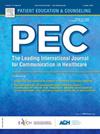Barriers and facilitators to shared decision making: A qualitative study of families who delivered at the cusp of viability
IF 2.9
2区 医学
Q2 PUBLIC, ENVIRONMENTAL & OCCUPATIONAL HEALTH
引用次数: 0
Abstract
Objectives
There is limited data regarding patients’ experiences with periviable counseling. Exploring patient perspectives helps us improve provider communication and may aid in supporting high-quality decision-making. Our study explored patient-identified sources of support and conflict during discussions with their healthcare team when delivering during the periviable period with the goal of improving high-quality shared decision making (SDM).
Methods
We conducted semi-structured interviews of birthing people who delivered between 20 0/7 and 25 6/7 weeks gestational age from 2010 to 2014. Interviews focused on shared decision making at the time of periviable birth with an emphasis on the three-talk model of SDM. Interviews were coded to perform thematic analysis.
Results
We interviewed 20 patients who delivered during the periviable period and 6 important others. Participants valued providers aiding in their emotional processing. Conversely, participants identified lack of clarity during counseling and an emphasis on hopelessness as barriers to SDM.
Conclusion(s)
Participants highlighted the importance of using easy-to-understand language and focusing on hope. Finally, families emphasized the importance of explicitly eliciting values that might inform their choice and the positive impact of nursing staff.
Practice Implications: Our findings underscore the importance of using a SDM model for periviability counseling and highlight areas for improvement.
共同决策的障碍和促进因素:对处于生存能力尖端的家庭的定性研究
目的:关于患者接受周边咨询的经验数据有限。探索病人的观点有助于我们改善提供者的沟通,并有助于支持高质量的决策。我们的研究探讨了患者在围生期分娩时与医疗团队讨论时确定的支持和冲突来源,目的是提高高质量的共享决策(SDM)。方法对2010 ~ 2014年孕周20 /7 ~ 25 /7周分娩的产妇进行半结构化访谈。访谈集中在围产期的共同决策,重点是SDM的三语模型。对访谈进行编码以进行专题分析。结果随访围生期产妇20例,重要产妇6例。参与者重视帮助他们处理情绪的提供者。相反,参与者认为在咨询过程中缺乏清晰度和强调绝望是sdm的障碍。结论(s)参与者强调使用易于理解的语言和关注希望的重要性。最后,家庭强调了明确引出价值观的重要性,这些价值观可能会影响他们的选择和护理人员的积极影响。实践启示:我们的研究结果强调了使用SDM模型进行濒死期咨询的重要性,并强调了需要改进的领域。
本文章由计算机程序翻译,如有差异,请以英文原文为准。
求助全文
约1分钟内获得全文
求助全文
来源期刊

Patient Education and Counseling
医学-公共卫生、环境卫生与职业卫生
CiteScore
5.60
自引率
11.40%
发文量
384
审稿时长
46 days
期刊介绍:
Patient Education and Counseling is an interdisciplinary, international journal for patient education and health promotion researchers, managers and clinicians. The journal seeks to explore and elucidate the educational, counseling and communication models in health care. Its aim is to provide a forum for fundamental as well as applied research, and to promote the study of organizational issues involved with the delivery of patient education, counseling, health promotion services and training models in improving communication between providers and patients.
 求助内容:
求助内容: 应助结果提醒方式:
应助结果提醒方式:


